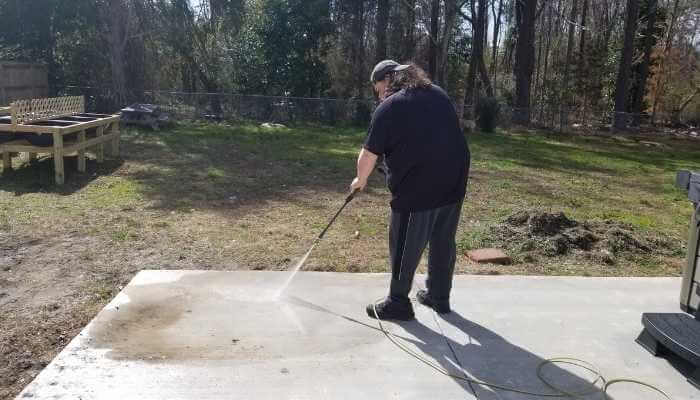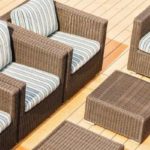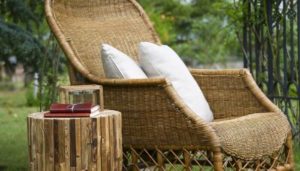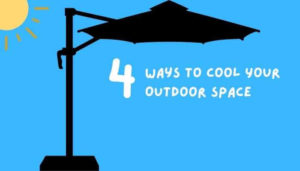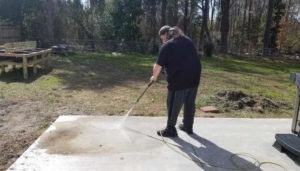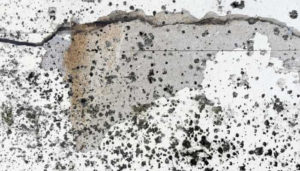
Sometimes, we’re so focused on the big things (furniture, patio, grills, hot tubs, etc…) that we overlook the little things. Cushions for your outdoor furniture make them comfortable. They add to the personality and style of your outdoor space. So, do you take care of yours?
Whether waterproof or water-resistant, patio cushions can still get mold and mildew. Keeping your outdoor cushions dry, taking care of them, and knowing how to clean them can save your cushions from mold and mildew.
First things first, we need to explain the difference between waterproof and water-resistant. Once you understand what is meant by these two labels on outdoor cushions, you’ll realize that water and moisture are still enemies that you’ll need to deal with. Let me explain.
Are Outdoor or Patio Cushions Waterproof?
There is a general misconception about this. For one thing, not all patio cushions are waterproof. You really need to look into the material your cushions are made of and what their coverings are made of.
Most cushions and their covers are just water-resistant. Decorative pillows especially are made from polypropylene or polyurethane materials. They are water-resistant which means the material only resists the penetration of liquid only to a certain degree.
Let’s take the foam. It’s usually made of a very porous material that allows water to pass through it. If it were made of memory foam or the same material indoor furniture is made of, the foam could get waterlogged.
Some cushion covers are actually made with this in mind. They’re made from materials that are porous and allow both water and UV light to flow through them. So they’re not waterproof at all, but because of this design, they tend to last longer. I know! It made no sense to me, but it works.
Cushions covered in a material called oilcloth are definitely waterproof. They’re made from a heavy material that is then coated with linseed oil. The problem with this material is that it’s not as comfortable as the water-resistant or porous material and because they wind up being so stiff, they’ll rip easier.
So, if you want comfy and longer-lasting, get the water-resistant or porous cushions, but be ready to take care of them. As soon as you get them, spray them with a waterproof or water-resistant sealant spray. It doesn’t matter if the material claims to be either – go by the can’s directions and spray them before you ever use them.
Do Outdoor Cushions Get Mold and Mildew?
Yes. If you leave cushions out where they can get wet or damp and they don’t dry quick enough, they can get mold and mildew. Mildew usually happens more often on the furniture, and mold on the cushions.
Even if you have furniture covers over the furniture and you’ve left your cushions on said furniture – if there is any moisture inside of the cover that doesn’t dry up quick enough, the cushions can grow mold and mildew. That’s why furniture covers come with vents.
How Do I Know It’s Mold or Mildew?
It’s important to know what you’re looking at when you have mold and mildew. Mildew is actually a form of mold. Both have a musty, old, dirty smell to them. But don’t actually sniff too close to these things. That’s simply the scent that lingers in the air, especially in enclosed spaces where mold and mildew occur.
Why should you not sniff? Because both mold and mildew are fungi that reproduce by putting off spores that can spread through the air. And those spores can cause headaches and respiratory issues in people and pets. That’s why it’s also a good idea to always use a mask while you clean up mold and mildew.
How to Identify Mold
Mold is usually fuzzy or velvet in texture. It has a dirty, musty smell. It can be found in shades of white, yellow, green, brown, gray, and black. Often it will appear like a dark spot or discoloration on your cushions.
How to Identify Mildew
Mildew usually has a flat either downy or powdery texture to it. You’ll find mildew colored white, yellow, brown, gray, and black. Mildew is most commonly found on patio furniture and not so much on the cushions, though it can happen.
Can Outdoor Cushions Be Washed?
There are several methods for cleaning outdoor cushions. Let’s go over how to clean them if mold or mildew has already set in. If you clean the patio cushions like this, you’re also being proactive against mold and mildew. Just always dry the cushions completely. Keep in mind, these methods can also be used for umbrellas.
The Homemade Borax Solution for Cleaning Your Outdoor Cushions
This is not as heavy-duty as bleach. You will need:
- A bucket of hot water
- A few drops of dishwashing detergent (I use Dawn)
- 1 cup of borax (a mineral salt scientifically known as sodium borate)
- A couple of tablespoons of baking soda
- Soft-bristled brush (not metal)
- Protective gloves for your hands
Mix these ingredients up in hot water until they dissolve. Then scrub the fabric lightly in a circular motion until the mold has been removed. Rinse thoroughly with the high pressure from a garden hose. Squeeze out any access water and lean them up against something in the sun so the fabric and foam can completely dry out.
Can Hydrogen Peroxide Remove Mold and Mildew from Patio Cushions?
Hydrogen peroxide works well to remove the smell associated with mold and mildew. However, it is really only effective at killing mold and mildew on solid surfaces, not on porous surfaces like fabric.
Can White Vinegar Remove Mold and Mildew from Outdoor Cushions?
Using white vinegar to clean mold and mildew from your outdoor cushions is an eco-friendly and non-toxic method of cleaning. It’s also a mild method of cleaning them, so if you’ve got a really tough problem, you may want to bypass this cleaning method. Here’s what you’ll need:
- A cloth
- Distilled white vinegar
- Spray bottle
- 1 tablespoon liquid dish soap
- Large bowl
- 3 cups warm water
- Sponge
- Water
If you can remove the cushion covers, this method can save you some time by having you remove those covers and wash them in a washing machine. Add 1 full cup of vinegar to the fabric softener dispenser.
Fill the spray bottle with vinegar. Spray it all over the cushions. Allow it to sit for 10 minutes. Mix the warm water with the dish soap. Soak the sponge in the mixture and scrub the cushions all over with it. Rinse them with a clean damp cloth. Squeeze out any access water and lean them up against something in the sun so the fabric and foam can completely dry out.
If you want to strengthen the power of vinegar, you can mix it with ammonia, baking soda, and water to create a solution that can kill mold and mildew. Here are the ratios:
- One gallon of water
- ½ cup white vinegar
- 1 cup ammonia
- ¼ cup baking soda
Can You Power Wash Patio Cushions?
Yes. You just need to be sure and use your pressure washer in the right setting and with the correct nozzle. You’ll need to set the cushions up in an open and safe area. What you’ll need:
- Pressure washer (hooked up and ready to go)
- Soap nozzle
- Cleaner for the pressure washer
- Protective gear (gloves/apron/glasses)
- Soft-bristled brush
- 40° nozzle for the rinse
Using the low-pressure mode, soak the cushions with water only. Then, with the cleaning solution of your choice, make sweeping movements over the cushions to create suds. Leave for 5 minutes. Scrub the areas with mold and mildew. Use the 40° nozzle to rinse the soap away. Squeeze out any access water and lean them up against something in the sun so the fabric and foam can completely dry out.
My suggestion for a cleaning solution for your pressure washer is the Simple Green Oxy Solve Total Outdoor Pressure Washer Cleaner.
Scrubbing Your Outdoor Cushions with Mild Bleach
Bleach is listed in almost every guide to cleaning things in your outdoor spaces. But, be careful not to make a bad situation worse by letting the bleach discolor your fabric. Make sure the manufacturer says that the outdoor cushions can handle some bleach or do a spot check in an inconspicuous place with your mixed solution to be sure it’s not too strong. Here’s what you’ll need:
- ½ cup – ¾ cup bleach to
- 1 gallon of water in a bucket
- Soft-bristled brush
- Garden hose
- Tarp (to protect the surface you’re working on)
- Protective gear (gloves/apron/glasses)
Lay your cushions on the tarp. Mix your solution. Test it on your fabric. Once you get it to the right strength, dip your brush in it and brush the cushions until they are saturated. Let it sit for 5 minutes. Rinse the patio cushions with high pressure from your garden hose. Squeeze out any access water and lean them up against something in the sun so the fabric and foam can completely dry out.
A Less Caustic Method: Lemon Salt
Lemon salt is an organic mold and mildew solution that you can use if you want to avoid using chemicals. It’s a simple solution; just mix lemon juice with salt and scrub away!
Important: Never use bleach and ammonia together. This is very dangerous and can produce toxic chemicals. Bleach in and of itself is a toxic chemical and should be handled with care.
And remember, you’ll probably also need to clean your furniture, not just the cushions if you have a mold and mildew problem.
How Do I Prevent Mold or Mildew?
Moisture is the enemy. Especially, if you live in humid climates. To prevent or discourage mold and mildew, you need to keep your furniture out of dark, damp places. Ideally, they should be out in the sunlight and not in the shade. So, when they aren’t being used by someone who loves the shade (like me) keep them in the sunlight, out from under trees. If they’re getting too much shade from umbrellas, readjust those when you can.
If the furniture stays mostly inside, make sure that there is a nice flow of air around your patio furniture and cushions. Fans are especially useful for this. And dehumidifiers work great if your furniture happens to be on an enclosed lanai, in a sunroom, or on an enclosed porch. The goal is to reduce the amount of moisture.
Have an indoor storage area for your outdoor cushions that is dry and clean, so they can remain moisture-free when it rains or it’s particularly humid out. Use water-proof cushion covers. If you don’t be sure to always use dry towels before you sit on your cushions with a wet bottom. If you spill something on a cushion, clean it off immediately instead of letting it sit and risk mold.
Keep a check on them to be aware if mold or mildew starts, and wash it off immediately so that the problem doesn’t get out of hand. If you want a good preventative, use a spray bottle of distilled white vinegar around, and periodically spray your cushions with it.
If the mold and mildew persist even though you’ve tried several of these methods, you may want to just throw in the towel and get new cushions. Just remember to always choose what works best for you – and take care of it to get the most out of your investment.
To learn more about how to take care of your patio cushions be sure to check out my article here.


